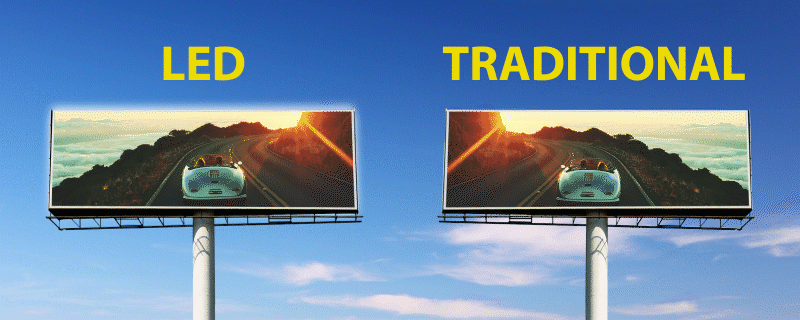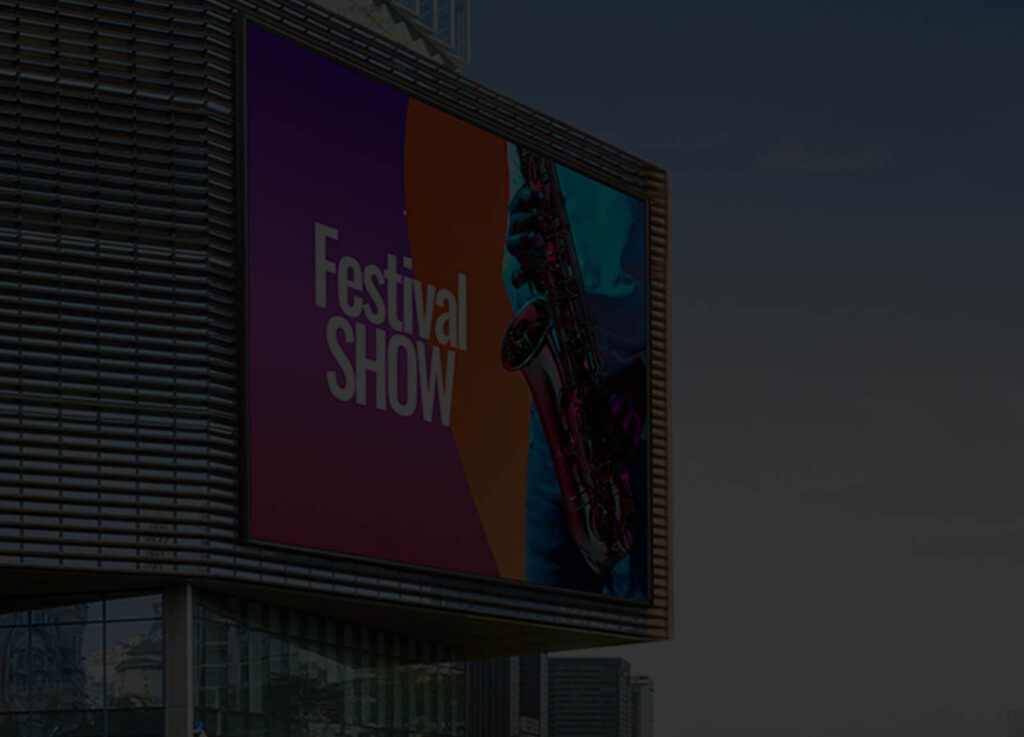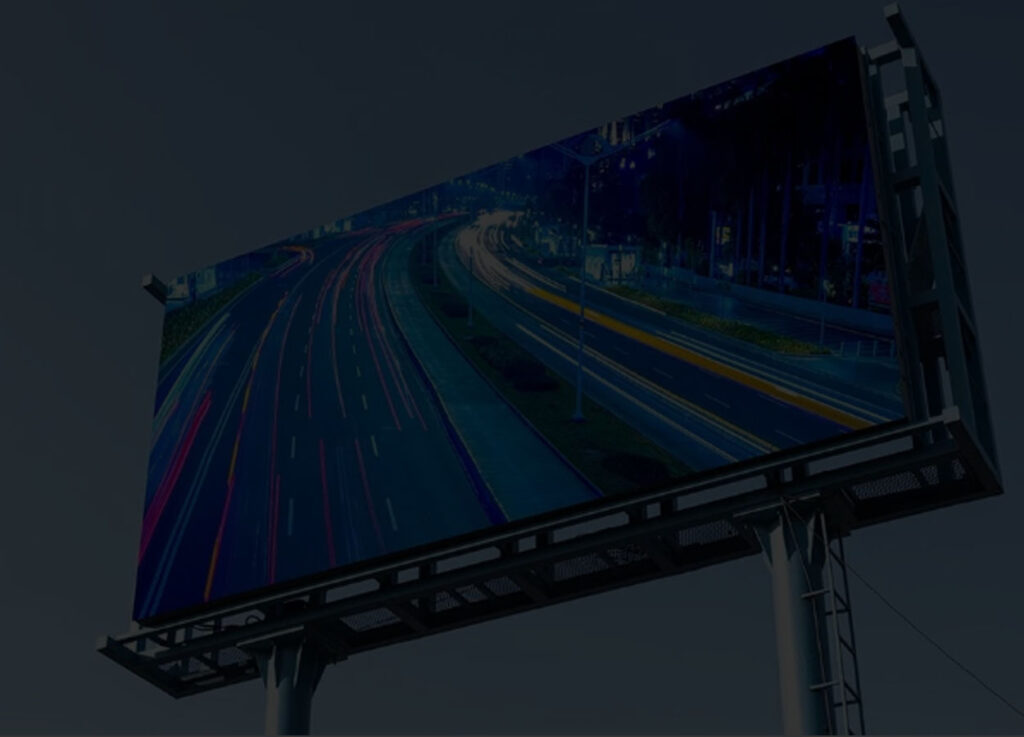
The difference between LED screens and traditional signs: – In modern commercial and public places, signs are an essential tool for conveying information.
From traditional fixed signs to LED screens, technological developments have revolutionized the display of information.
This article explores the differences between LED screens and traditional signs from different perspectives, helping businesses and organizations understand which type best meets their needs.
– What is the difference between LED screens and traditional signs?
– The difference between LED screens and traditional signs in terms of features.
– Types of LED screens and their applications.
To know the difference between LED screens and traditional signs, you must first know what they are and how they work.
What is the difference between LED screens and traditional signs?
Traditional signs.
They are advertisements displayed on physical signs such as LED screens, storefront signs, street signs, banners, or posters.
These advertisements use traditional methods of design and printing to convey messages, promote products or services, or increase awareness of a brand.
Traditional signs rely on static, non-dynamic visual elements and text to convey information or messages.
To know the difference between LED screens and traditional signs, you must know 8 elements.
Traditional signs. Advertisements are advertisements that are displayed on physical signs, such as LED screens, storefront signs, street signs, banners, or posters.
These advertisements use traditional methods of design and printing to convey messages, promote products or services, or increase awareness of a brand.
Traditional signs rely on static, non-dynamic visual elements and text to convey information or messages.
Traditional signs can take many forms, including:
Painted signs: These signs involve the use of paint on surfaces such as walls, windows, or panels. They can be hand-painted or created using stencils.
Carved signs: Carved signs are made by cutting or engraving into materials such as wood, stone, or metal to create raised or intricate letters and designs.
Dimensional signs: These signs are created using different materials to create 3D effects and can be made of individual letters or logos mounted on a support or created as a complete 3D structure.
Banners and flags: Banners and flags made of fabric or vinyl can be used for temporary or portable signage and are commonly used for events, promotions or advertising.
Traditional signs are typically static and do not offer dynamic or interactive features.
Changes or updates to the content of traditional signs often require manual intervention such as repainting or replacing the sign.
However, traditional signs can provide a sense of permanence, craftsmanship and physical presence that may be attractive in certain contexts.
LED Screens: Large-format screens displayed along highways, roadsides or in urban areas for advertising purposes are known as LED screens and typically consist of images, text and video.
The use of LED screens involves delivering dynamic and interactive content.
LED displays use technologies such as computer software, internet connectivity and content management systems to update and control the displayed content remotely.
LED screens can display a variety of multimedia content including videos, images, animations, and even real-time data.
Here are some of the characteristics of LED screen ads:
Dynamic Content: LED screen ads can feature dynamic and visually appealing content including videos, animations, images, and text.
The ability to incorporate motion and visually appealing elements helps to capture viewers’ attention and convey messages more effectively.
Real-Time Updates: LED screen ads can be updated in real-time, allowing advertisers to modify and update content remotely.
This flexibility allows for timely promotions, updates, or ads without the need for manual intervention or physical changes to the signage.
Targeted Messages: LED screen networks often use software and data analytics to target specific audiences or locations.
Advertisers can customize content based on factors such as demographics, time of day, or viewer proximity to the screen.
This targeting helps deliver more relevant and personalized messages to the target audience.
Interactivity: LED screen ads can include interactive elements, such as motion sensors or QR codes, allowing viewers to actively interact with the content.
Interactivity can enhance user experiences, provide opportunities for feedback, or facilitate transactions directly through the LED screen.
Metrics and Analytics: LED screen networks provide tools to measure the performance and effectiveness of ads. Metrics such as impressions, dwell time, engagement rates, and conversions can be tracked to evaluate the success of an ad campaign and inform future strategies.
The difference between LED screens and traditional signs in terms of features.
Content flexibility: Traditional signs typically display static content that is fixed once the sign is created.
On the other hand, LED screens allow for dynamic and flexible content.
It can display a variety of media including videos, animations, real-time data, and interactive elements.
LED screen content can be updated remotely and in real-time, providing greater flexibility and the ability to deliver relevant information at the right time.
Interactivity: Traditional signs are generally non-interactive and offer limited interaction with viewers.
On the other hand, LED screens can include this interaction with the content, accessing additional information, making selections, or even placing orders.
Interactivity enhances engagement and provides a more personalized experience for viewers.
Cost and time: Traditional signs often involve higher initial costs for materials, production, and installation.
Additionally, updating traditional signs can be time-consuming and may require physical labor, especially for large-scale installations.
While LED displays may have higher initial setup costs due to hardware and software, they offer more cost-effective content updates and faster dissemination of new information.
Changes can be made remotely and instantly, saving time and resources.
Targeting and Scheduling: LED displays allow for precise targeting and scheduling of content based on factors such as time of day, location, or audience demographics.
Allows for personalized messages to be displayed to specific audiences or in specific contexts. Traditional signage lacks this level of personalization and generally delivers a message to a general audience without the ability to adapt based on specific criteria.
Analytics and Measurement: LED displays provide the ability to collect data and analytics on content performance.
It can track metrics such as audience engagement, content views, and interactions, providing valuable insights into the effectiveness of a signage campaign.
Traditional signage does not offer this level of data collection and measurement.
Space and Flexibility: Traditional signage requires physical space for installation and display, limited by the size and design of the sign itself.
However, LED displays can utilize different display sizes, orientations, and formats.
It can be installed in different locations such as walls, kiosks, or even on mobile devices, bridges, roads, etc.
LED screens provide more flexibility in terms of space utilization and adaptability to different environments.
Both traditional signs and LED screens have their own advantages and applications.
Traditional signs can provide a sense of authenticity.
Environmental adaptability: LED screens are suitable for use indoors and outdoors, especially in bright outdoor locations.
The high brightness of LED screens ensures clear visibility of information.
Traditional signs: In outdoor environments, it may be difficult to read the content due to lighting conditions.
Maintenance and durability: LED screens have relatively simple maintenance and high durability. Screens can typically operate for tens of thousands of hours without needing to be replaced.
Traditional signs: are susceptible to environmental factors such as wind and rain, which require more frequent maintenance and replacement.
Return on investment:
LED screens: Despite the higher initial investment, displaying dynamic content and remote updates can attract more customers and increase brand visibility, resulting in a higher return on investment.
Traditional Signage: Lower initial costs but higher refresh rates which may result in a lower ROI in the long run compared to LED screens.
Customization:
LED screens: Can be customized to different sizes, shapes and resolutions based on customer needs providing more personalized solutions.
Traditional Signage: Limited customization usually limited by printing and material constraints.
LED screens offer flexibility, interactivity, real-time updates and the ability to deliver personalized and targeted content.
They rely on the visual impact and strategic placement of physical signs to grab attention and convey messages.
LED screen advertising offers several advantages over traditional signage including flexibility, real-time updates, targeting capabilities and interactive features.
They provide advertisers with opportunities to create engaging and personalized experiences for viewers while enabling better measurement and optimization of advertising campaigns.
Types of LED screens and their applications.
LED screens include outdoor LED screens and indoor LED screens.
Some of its types are widely spread in all public and private places such as banks, malls, supermarkets, universities, roads, bridges, schools, places of worship and other places that keep pace with the modern era and target a large audience.
For example, there are LED screen stands, which are a type of display screens used to display images, texts and video content.
It is characterized by high brightness that attracts the attention of the audience, conveys information and creates a unique and wonderful effect at the same time.
These screens are usually used at the entrance to the exhibition or the entrance to the exhibition hall, billboards or inside places such as malls, shops, banks and others.


